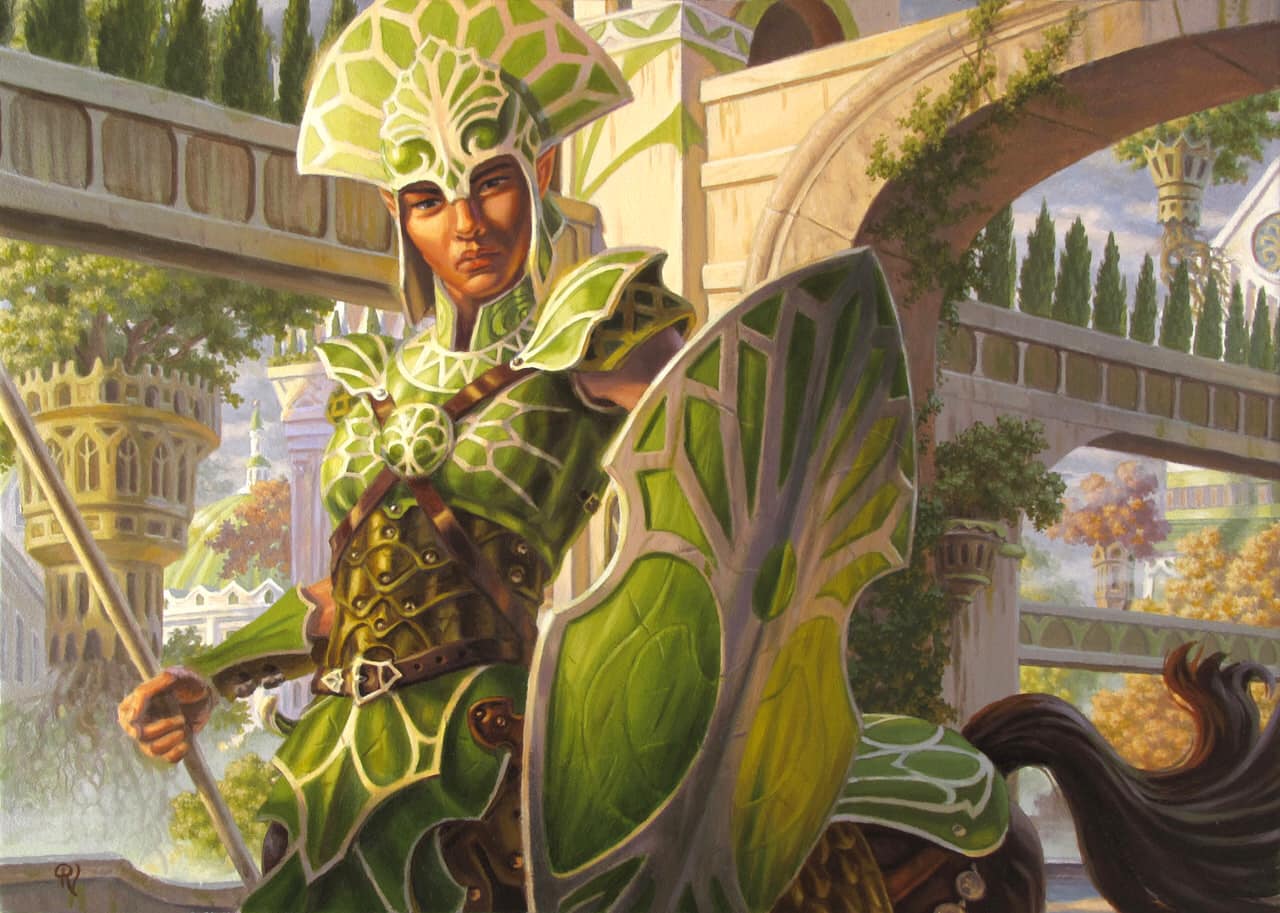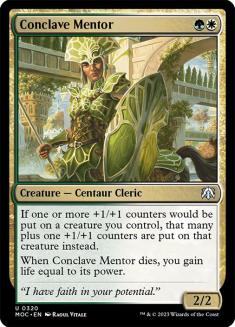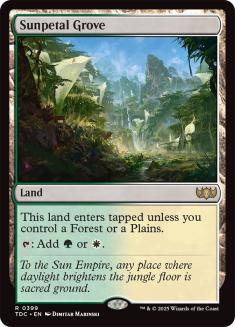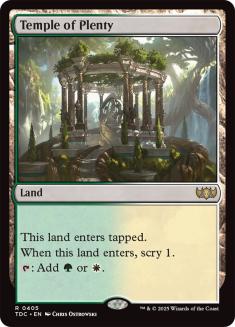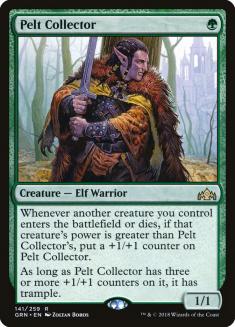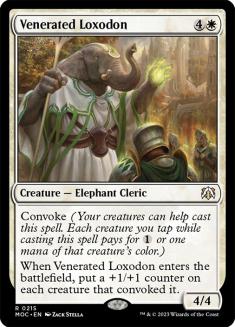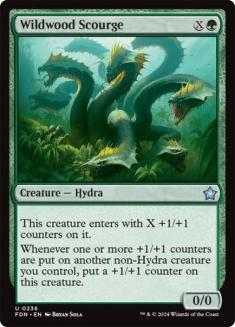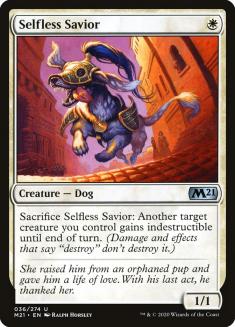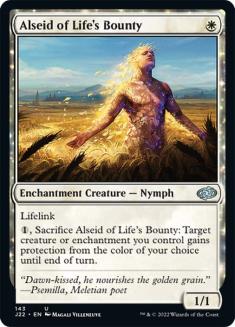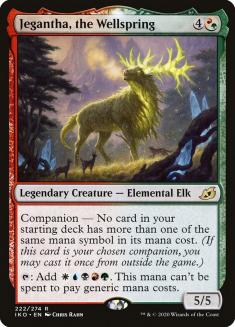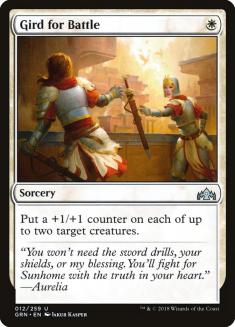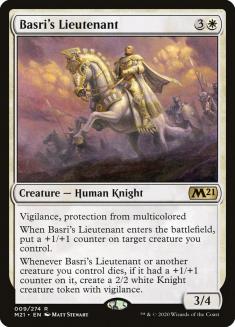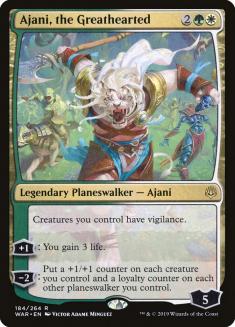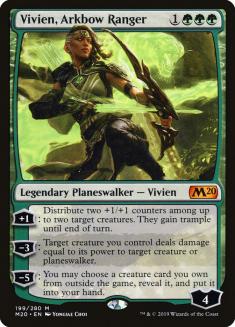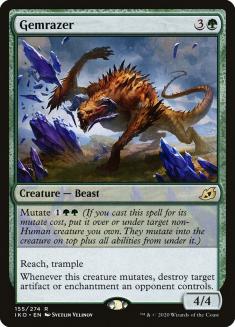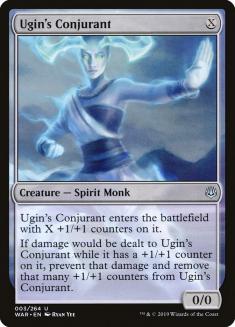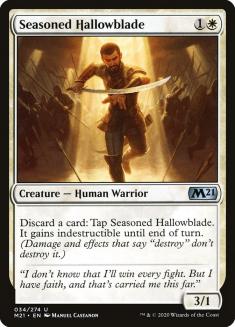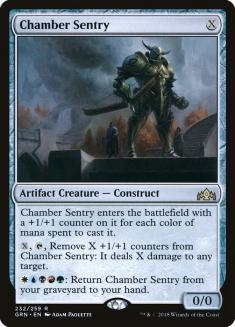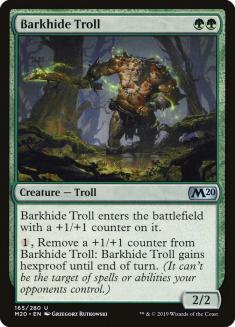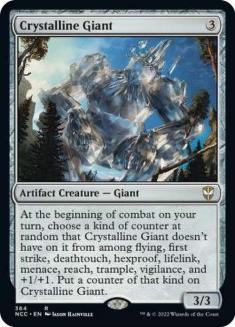As Paulo Vitor Damo da Rosa showed last week, there are a lot of different possible ways to build around Conclave Mentor. This week, I’d like to expand on the work he started with a closer look at the individual cards available to the archetype, rather than big picture different directions it can go. That is to say if his article was outlining options for deck selection, this will focus more on tuning.
Big picture, I think the mana for two-color aggro decks in Core Set 2021 Standard isn’t great, and when you want to reliably play a creature that costs GW on Turn 2, it’s better to have a more balanced manabase. Paulo leans toward playing base green or white, including in places where I think there’s little advantage to doing so, and I’d prefer to just attempt to minimize things that cost WW or GG. I’d note that I think it makes a lot of sense to choose a base color for one-drops in a format with Sunpetal Grove, but when we have Temple of Plenty instead, I don’t think there’s much of an advantage to trying to slant your mana, especially in a deck that can reasonably play several colorless creatures.
I think Pelt Collector is one of the best cards with Conclave Mentor, which makes me not want to lean heavily white. I do think Heliod/Lifegain is concentrated enough in white that it makes sense to build a deck that way and potentially just splash Conclave Mentor, and I also think a deck intent on casting Yorvo, Lord of Garenbrig can potentially splash Conclave Mentor, though I hate the mana in that deck. I want to start by looking at balanced Selesnya.
To me, one of the biggest questions is whether you want Venerated Loxodon. Venerated Loxodon really wants you to play as many one-mana creatures as you can. It adds a ton of power to the battlefield when combined with Conclave Mentor, but I don’t think you necessarily want it with Conclave Mentor because it’s possible to build the deck to make enough large creatures that taking a turn off to cast the Loxodon slows you down too much. Specifically there’s a lot of tension with Wildwood Scourge, a card Paulo and many others seem to be overlooking, but that I think is actually pretty strong in this kind of deck. Venerated Loxodon in particular makes it huge, but I think it gets big enough without Venerated Loxodon that the Loxodon could be overkill.
If I’m going to build around Venerated Loxodon, I think I want my curve to be something like 22 lands, twenty one-mana creatures, eight to ten two-mana creatures, four Unbreakable Formation, four Venerated Loxodon, and zero to two other spells. I could see playing fewer than four Unbreakable Formations, but I like the synergy between giving vigilance and then casting Venerated Loxodon.
In general, I think aggro decks like to have more removal than this, but in this particular Standard format I think it’s hard to get away with maindeck removal because the ramp decks that try to go over the top are so strong, and if you’re playing Venerated Loxodon you really want to maximize your creatures, so I’d end up with a deck like this:
Creatures (34)
- 4 Venerated Loxodon
- 4 Pelt Collector
- 4 Chamber Sentry
- 4 Stonecoil Serpent
- 4 Alseid of Life's Bounty
- 2 Seasoned Hallowblade
- 4 Selfless Savior
- 4 Conclave Mentor
- 4 Wildwood Scourge
Lands (22)
Spells (4)

Outside of creatures with counters, my creatures are optimized for resilience. Selfless Savior and Alseid of Life’s Bounty help minimize exposure to sweepers and protect your exceptionally big creatures.
The ideal play pattern with Wildwood Scourge is something like Pelt Collector on Turn 1, Wildwood Scourge on Turn 2, then Conclave Mentor and a one-mana Chamber Sentry or Stonecoil Serpent on Turn 3, at which point your Wildwood Scourge will be a 5/5 and your Pelt Collector will be a 3/3. Unbreakable Formation on the next turn would put it up to 13/13. In a lot of cases, this is overkill, but it’s particularly nice to make the biggest creature on the battlefield if other players are also playing green aggressive decks. It’s definitely reasonable to play four Seasoned Hallowblade and two Wildwood Scourge instead of the other way around if you anticipate more control decks than creature decks.
I see Alseid of Life’s Bounty and Selfless Savior as acceptable cards to round out this kind of deck, but I’m not excited about playing this many creatures that don’t grow Pelt Collector and don’t create counters. Playing with the archetype, I found myself preferring a different approach rather than using Venerated Loxodon.
Jegantha was literally an afterthought in this deck. After I finished the deck and sideboard I realized that I could use it as a companion, and that’s much better than a sideboard card.
Two cards that Paulo didn’t discuss that I’ve really liked — the first I’ve already talked about, Wildwood Scourge, and the other is Gird for Battle. I’ve seen other players use Basri’s Solidarity, but I think that’s overkill. Gird for Battle is strong enough and much more efficient, and I’m generally looking to cast it on Turn 3 either after casting Conclave Mentor or before casting Huatli’s Raptor. Basri’s Solidarity doesn’t offer anything comparable to either of those lines.
Gird for Battle is explosive. It leads to faster unchecked kills than Venerated Loxodon or Basri’s Solidarity. Core Set 2021 Standard as I see it at the moment consists of absurd big-mana decks that try to go over the top of everything (this includes both Wilderness Reclamation and Ugin, the Spirit Dragon decks) and decks that are trying to kill the opponent. Most of the kill-the-opponent decks are linear in some way, being built around counters or sacrifice or even pump spells or something, but basically players have to be very fast or very big.
You can’t play a midrange deck against Uro, Titan of Nature’s Wrath and Ugin the Spirit Dragon or Expansion // Explosion, and it’s very hard to play a true control deck against Uro; Nissa, Who Shakes the World; and Hydroid Krasis. Sweepers are generally pretty bad because the goal of a lot of decks is just to accumulate more lands. This means the aggro decks are basically trying to kill the big-mana decks before the big-mana decks do big proactive things and win races against each other.
Because of this, cards like Basri’s Lieutenant don’t make much sense to me. If all your creatures have counters, it means Kaya’s Wrath would leave you with a bunch of Knights, but I don’t anticipate playing against Kaya’s Wrath very much. A lot of the Shatter the Sky decks are really just trying to Ugin anyway, so I want to kill them, which doesn’t involve casting a four-mana creature with less immediate impact that Basri’s Acolyte.
The same principle applies to Ajani, the Greathearted. Putting counters on my creatures every turn sounds strong, but I’d rather save a mana and play Unbreakable Formation, which is much better at racing against creature decks and beating the clock against big-mana decks.
Basri Ket is a go-wide payoff, and I see counters decks as more about going big than going wide. I might be underestimating repeatedly using the plus ability, and I could see this playing well, though it still largely seems like it might be playing the wrong game in too many spots.
I think Vivien, Arkbow Ranger is a pretty compelling reason to try to play heavy green, and Gemrazer’s also nice. If you play both of these, you get a lot of trample, which is really nice against other creature decks.
My inclination toward trying to go fast led me to want to minimize my curve, which naturally lead to enabling Lurrus as a companion, and while, if it weren’t available, I might play a few more expensive cards, I think it’s worth leaning into since I was naturally so close.
Creatures (28)
- 4 Pelt Collector
- 4 Chamber Sentry
- 4 Huatli's Raptor
- 4 Ugin's Conjurant
- 4 Stonecoil Serpent
- 4 Conclave Mentor
- 4 Wildwood Scourge
Lands (23)
Spells (9)
Sideboard

Pelt Collector, Chamber Sentry, Stonecoil Serpent, and Conclave Mentor all seem untouchable to me. This build attempts to lean as hard as possible into the counters theme to maximize Huatli’s Raptor and Wildwood Scourge. I’ve previously played Selfless Savior to protect my big creatures, but I think I prefer the explosiveness of Ugin’s Conjurant, which also makes me stronger against Ugin, the Spirit Dragon and more explosive, since more things have counters to maximize synergies with all of my two-drops. It also means more of my one-mana creatures double as expensive plays later in the game. Ugin’s Conjurant’s “drawback” also helps mitigate this deck’s weakness to deathtouch creatures.
I added a Shadowspear to the maindeck and another in the sideboard because I found that I struggled with a lack of keywords and I could lose to deathtouch creatures or just getting chump blocked by Serrated Scorpions and stuff. Against other creature decks, lifelink and trample are exactly the abilities I’m looking for.
Gemrazer is also available for additional sources of trample (even more than it’s there for its Naturalize ability), despite the fact that I have to give up on Lurrus if I want to use it. The Great Henge is really strong in this kind of deck if you’re playing against another deck that can lead to stalled battlefields because you tend to be able to cast it for very little mana.
I’m sad about giving up on Seasoned Hallowblade because I think it’s really strong card, and it would be nice to have a durable target to power up with Gird for Battle, but I don’t really think it’s worth playing Gird without all of the two-mana creatures that care about counters, and I’m really not in the market for two-mana creatures thirteen through sixteen.
I’d suggest that Basri Ket and Seasoned Hallowblade play extremely well together, such that any time you want to play Basri you should really try to also play Seasoned Hallowblade.
While I’m skeptical of two-color decks featuring Yorvo, I think Vivien is incredible, as I’ve seen it do outstanding work with Winding Constrictor in Pioneer, so I think it’s worth seriously considering a green-based approach:
Creatures (30)
- 3 Scavenging Ooze
- 4 Pelt Collector
- 4 Chamber Sentry
- 4 Huatli's Raptor
- 4 Barkhide Troll
- 3 Voracious Hydra
- 4 Stonecoil Serpent
- 4 Conclave Mentor
Planeswalkers (3)
Lands (24)
Spells (3)

I’m tempted to play Yorvo here, but then I thought about how great Voracious Hydra has been with Winding Constrictor and decided that was probably a better three-mana play. Honestly, Gemrazer would probably also get the nod before Yorvo, which helps save us from needing GGG on Turn 3.
I don’t like Chamber Sentry as a maindeck card here, because I think it’s just too slow. I prefer the explosiveness of Barkhide Troll. I particularly like that if I play Pelt Collector and then Conclave Mentor, to make Pelt Collector a 3/3, Barkhide Troll still comes in as a 4/4 on Turn 3 to grow the Pelt Collector to a 5/5. I’m less sure that I prefer Barkhide Troll to Wildwood Scourge, but Voracious Hydra was a strong argument for avoiding Wildwood Scourge to avoid running into awkward curves due to its non-Hydra clause.
The last deck I want to look at is a weird twist on the artifact aggro approach, splashing blue for Emry, Lurker of the Loch:
Creatures (32)
- 4 Steel Overseer
- 4 Chamber Sentry
- 4 Gilded Goose
- 4 Emry, Lurker of the Loch
- 4 Gingerbrute
- 4 Stonecoil Serpent
- 4 Crystalline Giant
- 4 Conclave Mentor
Lands (26)
Spells (2)

As with the first deck, this is another “Jegantha as an afterthought” deck.
For the most part, I agree with Paulo that The Ozolith really doesn’t have a place in these decks because your creatures getting killed just isn’t a big enough part of what’s going on the format, but I think once Emry’s involved it makes sense, and it’s incredible with Crystalline Giant, since you start getting random keywords you never lose.
I also think Crystalline Giant is generally a little underrated and really fantastic with Steel Overseer.
I’m not especially optimistic about the deck because Emry’s just never really been good enough in Standard, but this does look fun. One awesome interaction I considered but couldn’t justify both because it’s too slow and the mana is too bad is Niambi, Esteemed Speaker, which can pick up Stonecoil Serpent to transfer its counters to The Ozolith.
While this last build is more likely a casual-competitive fun deck, I think there’s a good chance for Conclave Mentor in Core Set 2021 Standard. It’s not a sure thing, because the barrier to entry in this format is obnoxiously high, but I’ve seen reports of people having success with the archetype with lists that I think are off by several cards, which is a promising start. The main lesson I’d try to take away from this is to remember to keep your curve low and focus on how quickly you’re killing your opponent more than how large a battlefield you can make on Turn 5 or getting lost in building in too much resilience.
The Gird is the word.

